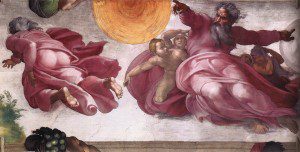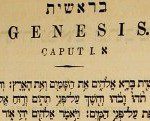
So, here’s the background of my click-bait post. I address several of these in my podcast on Genesis 1, or previous posts.
- Genesis 1 really likes the number 7. Can you spot all the multiples of 7 in there?
- You probably can’t, because even if you read Hebrew, these are not all exactly obvious.
“After the introductory verse (1:1), the section is divided into seven paragraphs, each of which appertains to one of the seven days….Each of the three nouns that occur in the first verse and express the basic concepts of the section, viz God [אֱלֹהִים ʾElōhīm] heavens [שָׁמַיִם šāmayim], earth [אֶרֶץ ʾereṣ], are repeated in the section a given number of times that is a multiple of seven: thus the name of God occurs thirty-five times, that is, five times seven; earth is found twenty-one times, that is, three times seven; similarly heavens (or firmament, רָקִיעַ rāqīaʿ) appears twenty-one times.
(e). The ten sayings with which, according to the Talmud, the world was created —that is, the ten utterances of God beginning with the words, and … said—are clearly divisible into two groups: the first group contains seven Divine fiats enjoining the creation of the creatures, to wit, ‛Let there be light’, ‘Let there be a firmament’, ‘Let the waters be gathered together’, ‘Let the earth put forth vegetation’, ‘Let there be lights’, ‘Let the waters bring forth swarms’, ‘Let the earth bring forth’; the second group comprises three pronouncements that emphasize God’s concern for man’s welfare (three being the number of emphasis), namely, ‘Let us make man’ (not a command but an expression of the will to create man), ‘Be fruitful and multiply’, ‘Behold I have given unto you every plant yielding seed’. Thus we have here, too, a series of seven corresponding dicta.
(f). The terms light and day are found, in all, seven times in the first paragraph, and there are seven references to light in the fourth paragraph.
(g). Water is mentioned seven times in the course of paragraphs two and three.
(h). In the fifth and sixth paragraphs forms of the word חַיָּה ḥayyā [rendered ‘living’ or ‘beasts’] occur seven times.
(i). The expression it was good appears seven times (the seventh time—very good).
(j). The first verse has seven words.
(k). The second verse contains fourteen words—twice seven.
(l). In the seventh paragraph, which deals with the seventh day, there occur the following three consecutive sentences, each of which consists of seven words and contains in the middle the expression the seventh day:
And on THE SEVENTH DAY God finished His work which He had done, and He rested on THE SEVENTH DAY from all His work which He had done.
So God blessed THE SEVENTH DAY and hallowed it.
(m). The words in the seventh paragraph total thirty-five—five times seven.”– Cassuto, Genesis.
- I’m not typically a fan of number symbolism, I think it’s too easy to manipulate and see what you want to see. However, given the obvious “seven day” pattern, I suspect these are not all accidental or impositions by the interpreter.
- As we have it today, Genesis 1 is the work of Israelite priests, not Moses.
- See my podcast and books like Mark Smith’s Priestly Vision of Genesis 1. (Also, my post here about nuances of “Mosaic authorship.”) For one Jewish read on the tradition of Mosaiac authorship, see here.
- Genesis 1 doesn’t portray the creation of a lone human couple but humanity in general.
- In 1:26-27, it says God creates humanity, male and female. The idea that this is a human couple is spillover from Genesis 2-3, where a human couple named Human and Life (or more traditionally Adam and Eve) are created. (On Human and Life, see my chapter “‘Adam, Where Art Thou?’ Onomastics, Etymology, and Translation in Genesis 2-3” in this book.
- The created humans are commanded to be vegetarian.
- Contrast 1:29-30 “I have given you every plant yielding seed that is upon the face of all the earth, and every tree with seed in its fruit; you shall have them for food, And to every beast of the earth, and to every bird of the air, and to everything that creeps on the earth, everything that has the breath of life, I have given every green plant for food.” (Gen 1:30 NRSV) with Genesis 9:3-4 “Every moving thing that lives shall be food for you; and just as I gave you the green plants, I give you everything. Only, you shall not eat flesh with its life, that is, its blood.”
- The “days” of Genesis 1 are literal 24-hour days, but don’t have anything to do with the age of the earth. Indeed, Genesis 1 (probably) isn’t even about physical/material origins.
- Arguments making the days of Genesis indefinitely long ages (the day-age interpretation, see my paper here) are based on the assumption of concordism, that science and scripture must be saying the same things, even if the latter speaks in “artistic” or “metaphorical” language. The more I study the Hebrew Bible, ancient Near East, and creation stories (as well as the history of science), the more I am convinced this assumption is completely baseless when applied to the Hebrew Bible. Genesis is not trying to present any kind of “natural history” of the world, and attempts to turn it into one are far off base. Any argument about interpretation of “days” as anything other than 24-hr periods must first acknowledge and provide a warrant for the validity of this assumption.
- “It is not too much to see in all this a common preoccupation with the scientific method, scientific evidence, and scientific results, which descend upon these ancient pages like a cloud of termites eager to devour and digest the materials in terms of their own appetites. This is not to debunk science or historiography as such. Rather, the issue is one of appropriateness. Our contemporary preoccupations could hardly have been the preoccupations of ancient Israel…. It is quite doubtful that these texts have waited in obscurity through the millennia for their hidden meanings to be revealed by modern science. It is at least a good possibility that the “real meaning” was understood by the authors themselves.… Charles Darwin, in comparing his observations of nature with the biblical accounts of creation, assumed that they were the same sort of statement and declared that the Old Testament offers a “manifestly false history of the earth.” While religious objections have tended to focus on the word false, and many evolutionists—following Darwin—have been inclined to agree that it is false, the central issue is whether the biblical materials are being offered as a “history of the earth” in a sense comparable to the modern meaning of natural history. If they are not, then both the attempts at demonstrating their scientific falsity and the attempts at demonstrating their scientific truth are inappropriate and misleading.” Hyers, Meaning of Creation:Genesis and Modern Science, 3, 6.
- Similarly, the argument that “they can’t be literal 24-hr days because the sun isn’t created until day 4” continues with concordist assumptions, that Genesis 1 is working within the framework of a modern cosmology and understanding. But Israelites had a very different cosmology, and they knew that daylight came even when the sun was “absent,” like on a cloudy day. Again, this is only an argument if you assume that Genesis has to be speaking about physical or material origins. Much later post-biblical Jewish interpretation says the light in the first three days was the light of God.
- Lastly, the argument that Heb. yom “day” can mean an indefinite period of time is true, but only in idioms which we do not find in Genesis 1, where the 24-hr meaning is supported contextually by things such as the “morning/evening” refrain and the modeling of ceasing all work on the seventh day, which loses all force if day doesn’t actually mean “day” here.
- So the days of Genesis are literal, but also literary, not actual, historical days. (If that seems confusing, the Cheshire cat is a literal cat, but not a real or actual cat.) That is, the presentation of creation in a seven-day period is not due to simply “recounting the past” or because “that’s how it happened,” but for other reasons which I don’t have space or time to go into here. My old post here gets at it a little, and I cover it in the book.
- There is also a question as to whether Genesis even depicts creation in physical/material terms. That is, it appears from ancient accounts that ancient Near Eastern peoples thought about existence less in physical terms (as we tend to today), and more in functional terms. To exist meant to have a name and a function within a system, and Genesis portrays the arranging of that system of functionality and naming. Genesis is the organization of God’s cosmic temple, not the physical construction of it (which is what modern science is discovering.) This is the argument of John Walton (see my links and brief discussion here), and while it has some problems, I think there’s something to it.
- Genesis 1 is only 1 of 3 creation stories/themes in the Old Testament, and they’re far from consistent with each other
- That is, there is Genesis 1-2:4, Genesis 2:4ff, and the tradition of the pre-creation battle with the waters scattered throughout Job, Psalms, Isaiah, etc. This is directly contradicted in Genesis 1. See, again, Mark Smith’s Priestly Vision of Genesis 1 or my old post here.
- The Bible devotes more than 12x as much space to the story of Joseph in Egypt than to creation in Genesis 1.
- By wordcount, this is easily true. Modernity has placed far more importance on Genesis 1 than the ancients apparently did, which also suggests the purposes we attribute to it are different than their ancient ones. LDS Old Testament scholar Sidney Sperry alluded to this when he wrote that “the writer of Genesis (in its present form) is more interested in showing to Israel who its great ancestors were than to tell about the origin of life and its institutions. This is readily seen in the fact that the origins of life and its institutions are briefly and concisely handled in the first eleven chapters, while thirty-nine chapters are required to tell about Abraham, the father of the faithful, and his immediate family.”
As always, you can help me pay my tuition here, or you can support my work through making your regular Amazon purchases through book links on my posts. You can also get updates by email whenever a post goes up (subscription box on the right). If you friend me on Facebook, please drop me a note telling me you’re a reader. I tend not to accept friend requests from people I’m not acquainted with.











